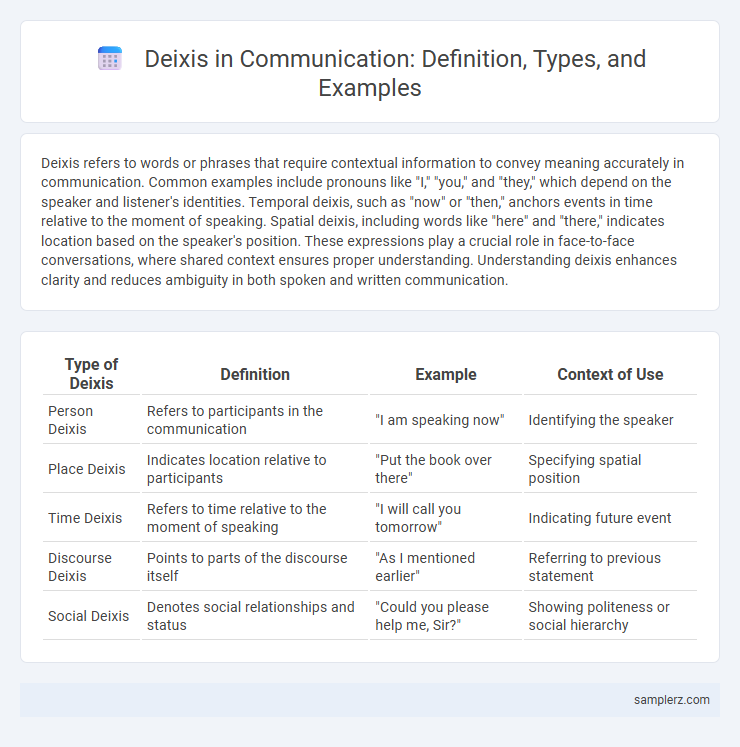Deixis refers to words or phrases that require contextual information to convey meaning accurately in communication. Common examples include pronouns like "I," "you," and "they," which depend on the speaker and listener's identities. Temporal deixis, such as "now" or "then," anchors events in time relative to the moment of speaking. Spatial deixis, including words like "here" and "there," indicates location based on the speaker's position. These expressions play a crucial role in face-to-face conversations, where shared context ensures proper understanding. Understanding deixis enhances clarity and reduces ambiguity in both spoken and written communication.
Table of Comparison
| Type of Deixis | Definition | Example | Context of Use |
|---|---|---|---|
| Person Deixis | Refers to participants in the communication | "I am speaking now" | Identifying the speaker |
| Place Deixis | Indicates location relative to participants | "Put the book over there" | Specifying spatial position |
| Time Deixis | Refers to time relative to the moment of speaking | "I will call you tomorrow" | Indicating future event |
| Discourse Deixis | Points to parts of the discourse itself | "As I mentioned earlier" | Referring to previous statement |
| Social Deixis | Denotes social relationships and status | "Could you please help me, Sir?" | Showing politeness or social hierarchy |
Introduction to Deixis in Communication
Deixis in communication refers to words or phrases that require contextual information to convey meaning, such as "this," "that," "here," and "now." These deictic expressions anchor conversations to specific times, locations, or participants, providing clarity and relevance. Understanding deixis is essential for decoding messages accurately and facilitating effective interpersonal communication.
Types of Deixis: Person, Place, and Time
Person deixis refers to the use of pronouns like "I," "you," and "they" to indicate participants in the communication context. Place deixis involves spatial terms such as "here," "there," and "nearby," which locate objects or events relative to the speaker's position. Time deixis includes temporal expressions like "now," "then," and "yesterday," anchoring the discourse in specific moments or periods.
Person Deixis: Referring to Participants
Person deixis in communication involves the use of pronouns and expressions to indicate participants in the conversation, such as "I," "you," "he," and "she." These deixis markers help clarify who is speaking, who is being addressed, and who is being referred to, enabling efficient and context-dependent interaction. Understanding person deixis is essential for interpreting meaning accurately in both spoken and written communication contexts.
Place Deixis: Indicating Location
Place deixis in communication involves using spatial references like "here," "there," "this," and "that" to indicate specific locations relative to the speaker or listener. For example, saying "I left the book over there" relies on shared understanding of the spatial context. Effective use of place deixis enhances clarity and orientation in face-to-face or mediated interactions.
Time Deixis: Referring to Temporal Points
Time deixis in communication involves using expressions like "now," "yesterday," or "next week" to specify temporal points relative to the speaker's current time. For instance, saying "I will meet you tomorrow" anchors the event to a future time from the moment of speaking, illustrating how temporal deixis situates events in a timeline. Effective understanding of time deixis enables clear scheduling and coordination in conversations by marking specific temporal references.
Discourse Deixis: Connecting to the Conversation
Discourse deixis plays a crucial role in communication by referencing elements within the conversation itself, such as "this," "that," or "the previous point." These deictic expressions anchor the listener's attention to specific parts of the ongoing discourse, ensuring cohesion and clarity. Effective use of discourse deixis enhances understanding by explicitly linking utterances to earlier or upcoming segments in the dialogue.
Social Deixis: Expressing Relationships
Social deixis in communication highlights the relationship between speakers by indicating social roles, status, or familiarity through language choices such as honorifics, titles, and pronouns. For example, using "sir," "ma'am," or "Dr." conveys respect and acknowledges social hierarchy, while the distinction between "tu" and "vous" in French demonstrates familiarity versus formality. These linguistic markers help establish and negotiate social relationships within conversational contexts.
Deixis in Spoken vs. Written Communication
Deixis in spoken communication often relies on immediate physical and temporal context, using words like "this," "that," or "here" to anchor meaning to the present situation. In contrast, written communication frequently lacks immediate context, requiring readers to infer deixis from broader textual or situational cues, making temporal and spatial references more abstract. This distinction affects how interlocutors interpret deixis, influencing clarity and understanding across communication modes.
Cultural Variations in Deictic Expression
Deictic expressions vary significantly across cultures, reflecting unique social norms and contextual references. For example, Japanese uses honorifics and varying pronouns to indicate social hierarchy and relationship distance, unlike English which relies more on spatial and temporal deixis. These cultural variations in deictic expression influence how meaning is constructed and interpreted in cross-cultural communication.
Practical Examples of Deixis in Everyday Communication
Deixis in communication often appears through words like "this," "that," "here," and "there," which depend on the speaker's context for meaning. For instance, in a conversation, saying "Put it over there" requires shared spatial understanding between the participants. Temporal deixis occurs when phrases like "now" or "then" are used, anchoring the message to specific times relevant to the communicators.

example of deixis in communication Infographic
 samplerz.com
samplerz.com